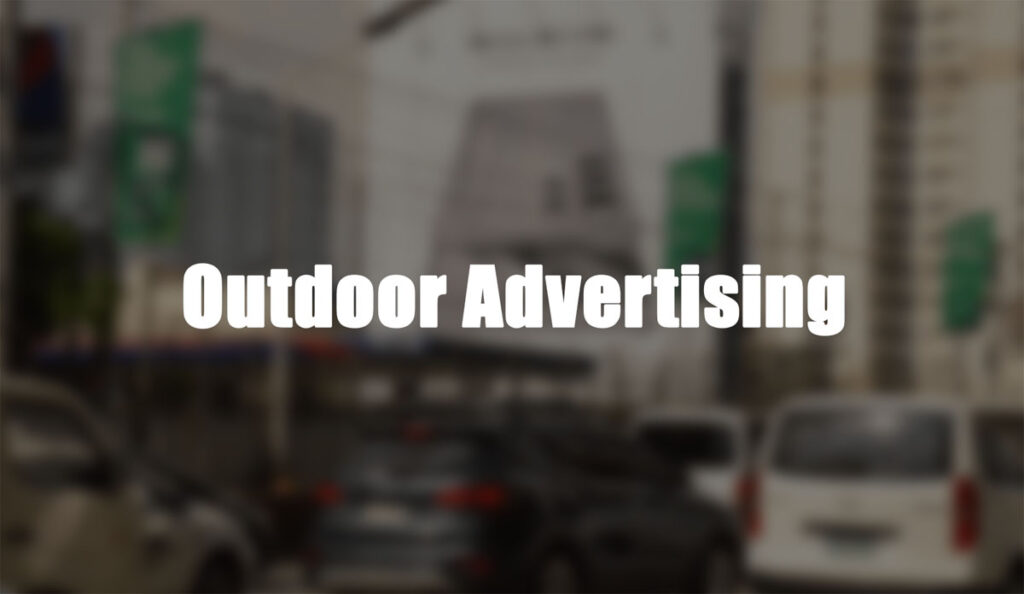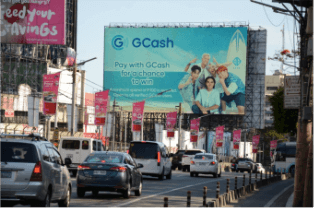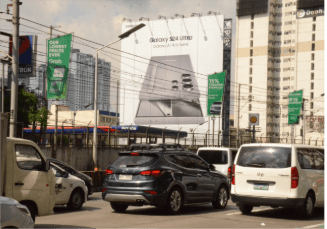Outdoor advertising, also known as Outside of Home (OOH), is any ad reaching consumers outside their homes. It’s an essential part of advertising and marketing strategies as it allows businesses to reach a wider audience outside. Outdoor advertisements efficiently bring the business more significant opportunities to create brand awareness and drive more sales. These advertisements target high-traffic areas, and they help businesses to:
- Develop brand recognition
- Reach a wider audience
- Increase sales through conversions from the wider audience reach
- Stand out from the competition and make a significant impact creatively
Any form of advertising that reaches customers directly, especially when they are not at home, is considered outdoor media. When people are out and about, it is intended to catch their attention. OOH (Out-of-Home) advertising is another name for this type of media. It is a widely accepted norm for public advertising.
What Is Outdoor Advertising?
- Targeting consumers outside of their homes sets outdoor advertising apart from other forms of advertising. It’s a powerful mass-market tool that reaches more potential customers who are only aware of particular brands.
- Designs for outdoor advertising must be striking and unambiguous. The advertisements need to be quick to understand and easy to read from a distance. This frequently restricts the quantity of information that may be communicated by giving priority to attention-grabbing images and succinct, memorable language. The capacity to leave a lasting impression is what makes outdoor advertisements creative.
- More creative freedom is possible with indoor advertising. Longer exposure periods allow for more engaging and complex advertisements. Dynamic material is available on digital panels and displays, which can adjust to the tastes of the viewer. Advertisers may tell a more captivating story and establish a deeper connection with the audience because to this versatility
Main Types of Outdoor Advertising (Out Of Home Media Examples )
1. Billboards (Static & Digital)
The most popular type of outdoor advertising are billboards. They are available in different sizes. They can be mobile, digital, or static. Some of the more recent ones make advantage of virtual reality, thanks to advancements in technology. A few are interactive.
The efficiency of billboards in promoting brand awareness and attracting customers is strong. The fact that people who are passing by on foot or by car only see billboards for a brief while is one of their drawbacks. The message must therefore be one that a prospective customer can understand in that brief period. There is no place for lengthy advertising content on billboards.
Like real estate, the position of billboards determines how effective they are. Billboards need to be positioned where many people can view them due to sightlines and traffic patterns.
2. Transit Ads (Buses, Taxis, Subways)
The subtlety of transit advertising is what makes it so effective. People on the go can easily incorporate it into their regular routines, blending in with their surroundings without interfering. Your brand becomes more approachable with this non-intrusive strategy, creating a feeling of familiarity that may eventually result in devoted customers.
Because of its wide audience, transit advertising is also relevant. It crosses the various socioeconomic groups and populations that depend on public transit. Your message appeals to a broad range of people, including professionals, students, city inhabitants, and visitors, which increases the visibility of your business and its prospective clientele.
a. Bus Ads
Visually striking promotional items that are strategically attached to the outside and sometimes inside surfaces of buses are referred to as bus advertisements. These displays allow advertisers to efficiently spread their message throughout the city by acting as mobile billboards. In a dynamic, constantly changing modern environment, bus advertisements use the vehicle transit network to draw in both pedestrian and vehicle audiences, increasing brand exposure and memory.

b. Subway Ads
Subway advertising are carefully designed promotional images that are displayed in the subway stations and, at the same time, within the subway vehicles. These advertisements leverage captive transit audiences by functioning as ubiquitous platforms for targeted communication, capturing brand storylines in high-traffic settings. Tube advertisements maximise the potential for brand resonance within the setting of daily journeys by employing innovative design and intelligent placement.
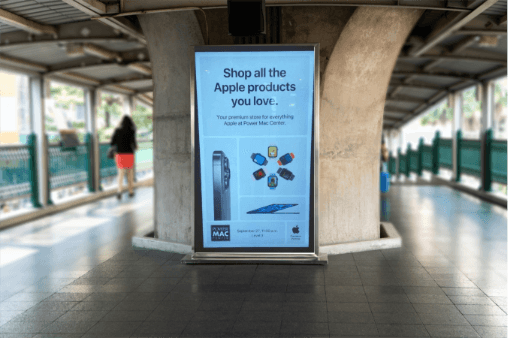
c. Taxi Ads
Taxi advertising refers to carefully chosen brand messaging that is placed on the outside of taxicabs, creating a moving billboard that may be seen in both urban and suburban areas. This advertisement enable maximum brand exposure across a range of demographics by acting as a mobile extension of the advertising infrastructure. It increases brand awareness and message assimilation because of its pervasiveness and regular exposure to both pedestrian and vehicle audiences.
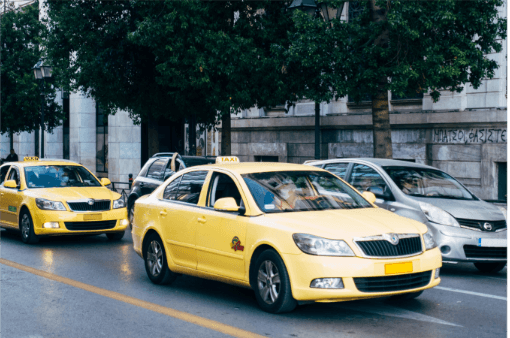
3. Street furniture (benches, kiosks)
When you walk down the street, wait for a ride, or browse a store or mall, street furniture advertising—also known as street-level urban media appears at eye level for convenient viewing. It provides a powerful means of interacting with both commuters and pedestrians.
a. KIOSK
Freestanding displays in a variety of sizes and designs are part of the kiosk advertising meaning. The displays offer a long-term, secure location for advertising within the kiosk. Additionally, digital kiosks have grown in popularity. Malls, airports, stadiums, train stations, shops, and more all have kiosks.
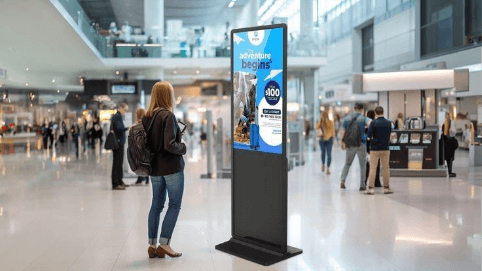
b. Bench
Bench advertising involves displaying advertisements on benches, often in public spaces like bus stops, parks, or shopping centers, to reach pedestrians and commuters. This form of outdoor advertising offers a cost-effective way to place ads at eye level for those who are sitting or walking by.
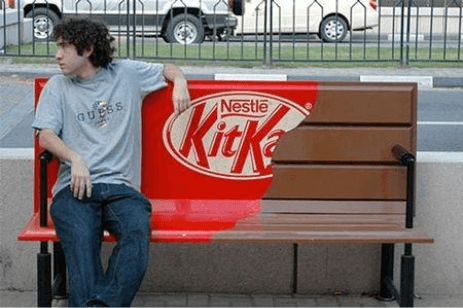
Traditional vs. Digital Outdoor Advertising
Comparative table: cost, reach, flexibility
| Category | Traditional Outdoor Advertising | Digital Outdoor Advertising |
| Cost | 1. Increased upfront setup expenses for things like posters and billboards 2. The cost of maintenance (including printing, installation, etc.) is often higher. 3. Usually entails longer-term agreements with more up-front expenses. | 1. Digital screens (LEDs, digital billboards, etc.) require a larger initial setup. 2. Constant expenses (electricity, platform usage, and content upgrades) could be less expensive than using conventional techniques. 3. Price flexibility dependent on demand and time (potential cost-per-impression model). |
| Reach | 1. Geographically restricted to the ad’s location. 2. In places with a lot of traffic, like city centres and highways, it can be very successful. 3. Long-term effects as a result of regular exposure. | 1. The capacity to target particular locations, times, and even demographics (based on data-driven judgements) may allow for the possibility of reaching a larger audience. 2. It can be dynamically modified to concentrate on times and places with high traffic. |
| Flexibility | 1. After the advertisement is put, there is little room for modification (static design, set positions). 2. Changes, like reprinting billboards, can be costly and time-consuming. | 1. High content delivery flexibility (real-time ad updates are simple). 2. The capacity to run many advertisements simultaneously, modify content according to the time of day, event, or both, and even customise material for audience segments. |
Costs of Outdoor Advertising (With Examples)
Break down pricing by format (e.g., $ per 1,000 impressions)
| Location 1 | PHP 170-200 per spot |
| Location 2 | PHP 35-50 per spot |
| Location 3 | PHP 40-45 per spot |
Tips for budget planning and negotiating rates
1. Identifying your target audience for effective billboard placement
Any billboard advertising strategy must have a thorough understanding of the demographics, interests, and behaviours of its target audience. When billboard placement is done strategically and according to the unique traits of your target audience, it can greatly increase exposure and engagement. The target population is more likely to frequent upscale neighbourhoods or commercial districts; therefore a billboard advertising luxury timepiece would be more successful there. In a similar vein, placing products targeted at younger customers close to educational institutions or leisure areas may increase engagement rates.
2. Choosing the Right Locations for Maximum Visibility
To maximise the impact of your billboard advertising campaign and guarantee a good return on investment, you must secure the best locations. The visibility and efficacy of the campaign can be greatly impacted by the thoughtful positioning of billboards. High traffic locations must be taken into account, but so must the location’s applicability to your target market. A billboard advertising luxury items, for example, would do well in commercial districts or affluent neighbourhoods, whereas a product geared towards families might do better close to residential areas and schools. It is essential to compare locations based on cost-effectiveness, demographic matching, and traffic data.
3. Deciding on the Perfect Timing for Your Outdoor Campaign
Any outdoor advertising campaign’s success depends heavily on timing. Your target audience will be reached when they are most responsive by a strategically scheduled campaign that maximises visibility and impact. In order to take advantage of the higher customer spending, retail enterprises can discover that the weeks preceding the Christmas season are the most profitable for outdoor advertising. On the other hand, you can greatly boost the exposure of your ad by starting a campaign around your billboards around an important event. Finding the best time for your campaign requires analysing consumer behaviour patterns and market trends.
How to Plan an Outdoor Campaign
1. Location Selection Strategy
Prioritise areas with high foot or vehicle traffic that fit the demographics and behaviour of your target audience when choosing places for an outdoor campaign. When taking into account expenses, the presence of competitors, and environmental considerations, urban centres, highways, and regions close to significant events or densely populated commercial districts are frequently the best places for visibility. Utilise digital billboards’ capacity to target particular events or times of day for more effective reach and pick sites that meet the demographic and geographic requirements of your campaign.
2. Messaging and Design Tips
Outdoor messaging should have bold, clearly legible typography and be no more than 6–8 words long. It should also be visually stunning and clear. Use brand-representative, high-quality visuals to highlight a single, important message, such as a clear call-to-action (CTA). Use high contrast colours for optimal visibility and make sure the design is functional in both daytime and nighttime conditions. Make sure your logo is visible for brand awareness and keep it basic to grab attention fast.
3. Booking Process and Timelines
Start the reservation process as soon as possible, preferably three to six months in advance, particularly for popular destinations or during busy times of the year. Digital billboards may be set up in 1-2 weeks, whereas traditional billboards require a longer lead time for production and installation (2-4 weeks). Send in finished designs well in advance, and always ask for proofs before approving them. While long-term campaigns often last three months or longer, short-term campaigns can last one to two weeks. Digital ads provide greater scheduling and content rotation flexibility.
Measuring ROI of Outdoor Ads
Impressions vs. Conversions
It’s critical to differentiate between impressions and conversions when calculating return on investment for outdoor advertisements. While conversions track the actual actions individuals take, like visiting your website or making a purchase, impressions are the overall number of people that saw your advertisement. High impressions can be produced by outdoor advertisements, but it’s important to monitor if these views result in actual customer behaviour. To maximise return on investment, evaluate the campaign’s efficacy by comparing its cost to the conversion rate (such as sales or website visitors).
Combining with QR Codes, Mobile Tracking, and Social Response
Using QR codes, mobile tracking, and promoting social media comments are some efficient ways to close the gap between impressions and conversions. By enabling customers to scan your advertisement and interact with your content directly, QR codes increase the amount of measurable traffic that reaches your website or landing page. Additionally, tracking of particular activities prompted by the advertisement is made possible by the use of technologies like Google Analytics or UTM links. You can monitor customer engagement directly through social media engagement (likes, shares, hashtags), which also offers insightful information about the efficacy of campaigns.
Audience Measurement Tools (e.g., Nyxsys)
Make use of audience measurement solutions such as Calton Datx by Nyxsys to obtain more precise data. This technique measures the audience exposure to outdoor advertisements using location-based technologies and sophisticated analytics. Calton Datx gives you a more accurate view of the performance of your outdoor advertisement by monitoring variables including dwell time, demographic information, and traffic patterns. To maximise ROI, you can use this information to modify your approach, choose the best locations, and polish creative components.
Outdoor Advertising FAQs
Digital outdoor advertisements use electronic screens, which provide more specific targeting (e.g., time of day, weather, audience demographics) and dynamic content changes than traditional outdoor ads, which are static (billboards, posters).
Select places according to the demographics and behaviour of your target audience. The best results will come from locations with plenty of traffic, close to events, and close to your desired customer base.
The location, scale, and length of the campaign all affect the cost. Digital billboards frequently offer more flexible pricing based on CPM (Cost Per Thousand Impressions), but traditional billboards typically have greater setup fees (printing, installation).
Ready to make Outdoor Advertising works for you?
Outdoor ads can do a lot, from getting your brand noticed to reaching more people every day. But planning the right campaign takes the right support.
At Nyxsys Philippines Inc., we help businesses choose smart locations, create eye-catching displays, and track results with real-time data.
Want to learn how we can help you using outdoor advertising? Get in touch with Us, we’re happy to help.

